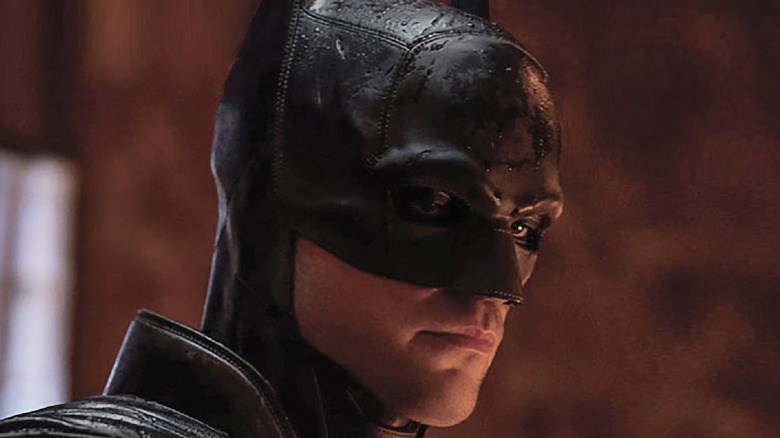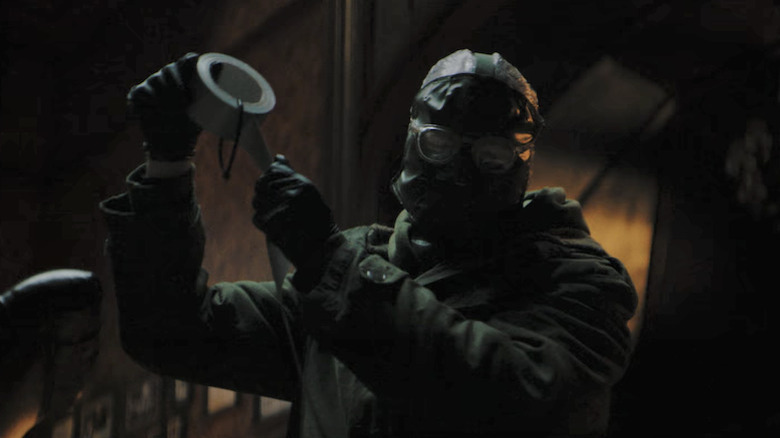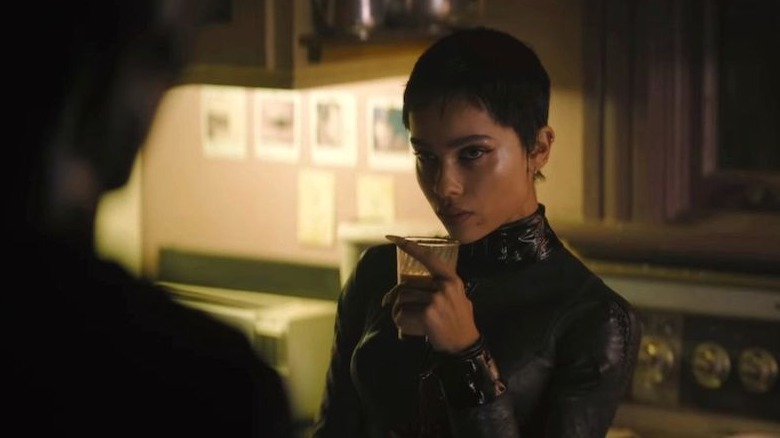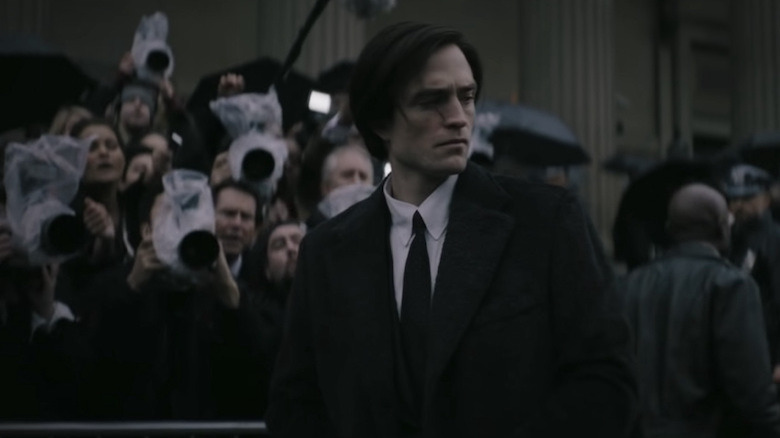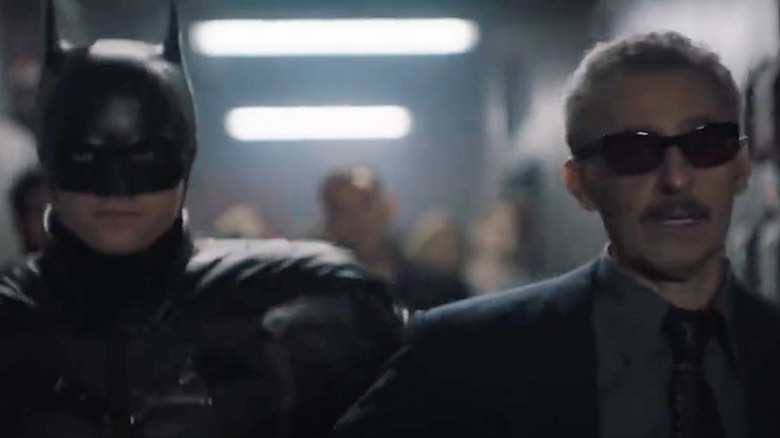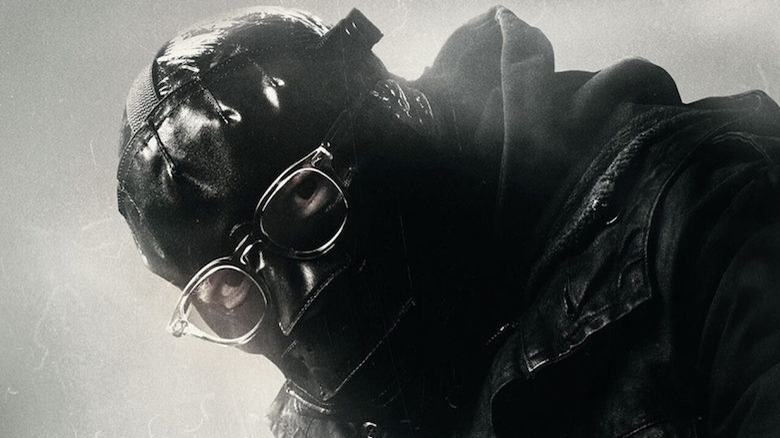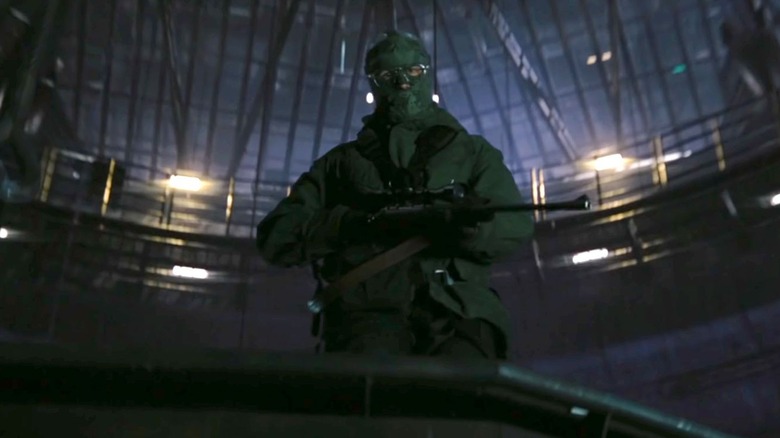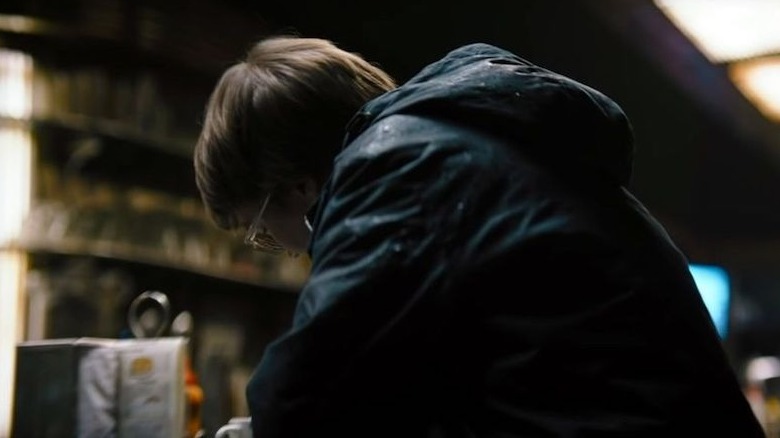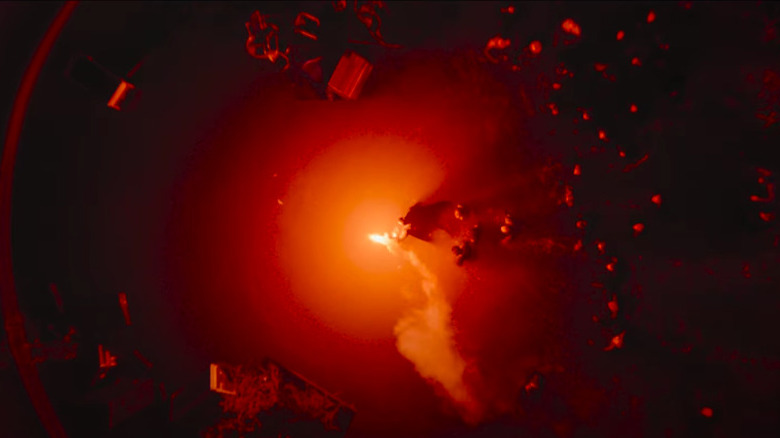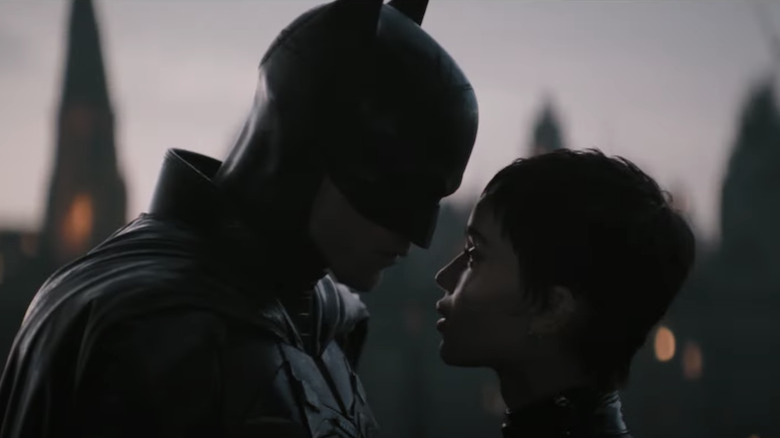The Ending Of The Batman Explained
Riddle me this: What's black, gray, and already a huge hit with critics? You guessed it, it's "The Batman." Matt Reeves has finally delivered his unique take on the legendary DC hero with a neo-noir detective thriller that sees Robert Pattinson's Caped Crusader tackle the Riddler (Paul Dano) in a battle for Gotham's heart. The movie started out as a vehicle for Ben Affleck's version of the hero set in the DC Extended Universe, and it would've seen him face off with Joe Mangianello's Deathstroke. Unfortunately, Affleck stepped away from the movie back in 2017, and Warner Bros. went back to basics, hiring "Cloverfield" and "War of the Planet of the Apes" director Matt Reeves to execute a brand new vision.
Fast-forward to 2022, and "The Batman" has finally swooped into theaters. The story follows the World's Greatest Detective as he attempts to figure out the truth behind the Riddler's savage plot to root out corruption at the highest levels of power in the city. The brutal killer takes aim at the Mayor, the Gotham City Police Department, the mobsters who corrupted the authorities in the first place, and the legacy of Bruce Wayne's parents. Yes, our moody hero even has to grapple with the possibility that Thomas and Martha Wayne weren't the saintly philanthropists he remembers.
He's not waging a one-man war on the Riddler though, as he's also joined by Lieutenant James Gordon (Jeffrey Wright), faithful butler Alfred Pennyworth (Andy Serkis), and the seductive Selina Kyle (Zöe Kravitz). But what's the Riddler's end goal? How does Batman stop him? Will Bruce Wayne ever be happy? Here's the ending of "The Batman" explained.
The Riddler wages war on corruption
The Riddler takes aim at the inherently corrupt institutions that hold Gotham together, and he starts with Mayor Mitchell (Rupert Penry-Jones). The murder itself feels right out of a slasher horror like "The Strangers" or "Hush," as the villain finds his way into the Mayor's apartment in the dark, stands behind him, and waits for his moment to strike. It's immediately clear that it's a huge step away from the prancing trickster played by Jim Carrey in "Batman Forever."
This is Matt Reeves' way of introducing us to the type of threat Batman is up against — a villain who isn't afraid to creep around in the dead of night and commit heinous atrocities in the name of vigilante justice. Hang on, that sounds an awful lot like what Bruce Wayne does, doesn't it? Interesting. Anyway, the first attack is what sends the Dark Knight and James Gordon tumbling down a conspiratorial rabbit hole regarding the Mayor's nighttime activities.
Although they find photographic evidence on a thumb drive that he's been having an affair with a young woman, the Riddler also sends the images to the press. So from the very beginning, the Riddler's whole agenda is to force the wrongdoers out into the light; he wants them to be humiliated for their crimes. And as the police scramble to look for the Riddler, he strikes again — this time targeting Commissioner Pete Savage (Alex Ferns). He sends a unique message by killing Savage with a horde of rats in a box strapped to the poor guy's face. As Bruce soon figures out, there's a rat at the heart of Gotham's corruption that's caught the Riddler's eye.
The Riddler calls this person, "el rata alada" — the rat with wings.
Selina Kyle joins the investigation
As it turns out, Selina Kyle's best friend, Annika, is the girl who's been spending extramarital time with Mayor Mitchell at the seedy Iceberg Lounge, and her face is quickly plastered across every TV screen in the city because of Batman and Gordon's investigation. Although Selina tries to protect her, it isn't long before she disappears. This is what draws Selina and Batman together, as he promises to help her find out what happened to her best friend. The cat burglar is only further inspired to get to the truth when she discovers that Annika has been spending time in 44 Below, the mob's "club within the club" at the Iceberg Lounge.
The secretive establishment is basically a playground where the rich and powerful get to do anything and everything they want away from the prying eyes of the law. This also gives the mob all the blackmail material they could ever need to keep the city in a vice-like grip. It quickly becomes clear that Annika has been kidnapped for things Mayor Mitchell has told her about the inner workings of his campaign — and who he really works for.
Selina makes it clear that she won't stop at anything to help find her friend, even if Batman is too preoccupied with the Riddler. Catwoman has spent most of her life on the streets fending for herself and helping "strays," so it's unsurprising that her compassion drives her forward to make sure her friend is okay. But Annika is yet another victim of corruption, as the Cat and the Bat ultimately discover her dead body while they're looking into Penguin (Colin Farrell) and his role in the mob.
This only hardens Selina's resolve to get revenge. It's truly vigilante season in Gotham, with Catwoman, Batman, and Riddler all out enforcing their own competing brands of justice.
The Wayne legacy
Sure, Bruce doesn't really spend much time as a billionaire playboy philanthropist, but the world hasn't forgotten about the Waynes and what his parents did for the city. However, the Riddler forces the hero to look closer at his legacy as he takes aim at Thomas Wayne and his unsuccessful mayoral campaign. Wayne Sr. started the 'Renewal Project' as part of his run for mayor, pouring millions into an initiative intended to help the poorest in Gotham.
But the fame and attention brought the paparazzi to his door — including a journalist working for the previous mob boss, Sal Maroni. In a surprising revelation, we learn that Bruce's mother is a member of the Arkham family. Before her untimely death she struggled with her own mental health issues. Martha Wayne was even committed to a psychiatric facility — something Thomas was desperate to keep out of the papers. His old friend Falcone even had a journalist killed to keep Martha's secret. The Riddler uses this as ammunition against the Wayne family, suggesting that Thomas was just as corrupt as Mayor Mitchell and Pete Savage. It's a crushing blow for Bruce, who holds his parents' memory in such high regard.
So Batman has a crisis of identity. This information threatens to invalidate his entire heroic crusade in Gotham. Bruce Wayne would be hypocritical for not addressing corruption in his own family — glass Batcaves, and whatnot. Thankfully, Alfred convinces him that Thomas didn't care about his mayoral campaign or preserving his status; he only wanted to keep Martha's secret so that she wouldn't be humiliated in the press. Yes, Thomas asked Falcone for help — but he didn't want to assassinate the journalist.
Not only does this chat restore Bruce's faith in his mission, it also forges a closer bond between the hero and Alfred.
Will the real el rata alada please stand up?
So, who is "el rata alada" and why are they so important? Well, it all stems from Thomas Wayne's Renewal Project. After the Waynes' deaths, the city's elite started to use the millions intended to help Gotham's poorest to line their own pockets. The perpetrators of this conversion included gangster Sal Maroni, but when the Mayor and various other powerful figures got greedy, they decided to get rid of him. The problem is that they used an anonymous informant, el rata alada, to do it. Surprisingly, this mystery snitch is none other than Carmine Falcone.
Is a falcon a rat with wings? Sure, just don't think about it too much. Carmine saw this as an opportunity to extend his reach across Gotham — to essentially have the Mayor, the District Attorney, and the Police Commissioner in his pocket. Unfortunately, Selina Kyle also figures out that Carmine is the one who ordered Annika's death, and she almost kills him in revenge. It's understandable why Selina takes a shot at him, because she's also his illegitimate daughter. Her assassination attempt is the culmination of 20 years of pain knowing that he abandoned her mother. Although Batman stops her from actually murdering Falcone, the Riddler finishes the grim job with a rifle.
Falcone's served his purpose in the Riddler's game, and now it's time for him to pay for his crimes. At least one Gotham vigilante gets their mark.
The Riddler suffered as a child because of the Renewal Project
Thankfully, because the Riddler left himself vulnerable by staying near the crime scene, it doesn't take long for the GCPD to track him down and haul "Edward Nashton" over to the Arkham Correctional Facility. Yes, it's time for the typical "villain explains their plan in great detail" part of the movie. We joke, but Nashton's explanation actually serves a key purpose this time beyond lazy exposition: He reveals the true extent of the corruption that has gripped Gotham for decades, and forces the audience to face an uneasy comparison between himself and the Caped Crusader. You see, Riddler used to work for the Waynes' Renewal Project as a forensic accountant, and that's where he discovered the dark truth.
While the wealthy elite got richer by skimming from Renewal, Nashton was growing up in one of the orphanages that should've benefited from that money. Instead, the villain had to endure a horrific childhood in squalor with other underprivileged kids. He even says that babies died during the winter because the buildings got so cold. It's a haunting thought, one that makes Riddler's own quest for vengeance a little more understandable. But he makes a disturbing confession: He was only spurred into action when he saw how Batman was tackling crime on Gotham's streets.
Yes, Bruce helped give birth to the Riddler; he inspired the killer to take the leap into vigilantism, meaning there's plenty of blood on those bat-hands of his. To be fair, the film makes a point of showing just how brutal Batman is to the point that the civilians aren't even sure if he's a friend or foe. It's hardly surprising that other self-righteous folk would follow in his boot-steps.
Unfortunately, there's little time for soul searching here, since Riddler has already rigged bombs around Gotham's sea wall as the final act in his war on the city.
The sea will cleanse Gotham
The final stage of the Riddler's plan sees the villain bomb the sea wall, which floods most of the city in a moment comic readers will recognize from the pages of the New 52's "Zero Year" event (via Fandom) in the comics back in 2013 — oh yes, Matt Reeves did his homework. Anyway, the Riddler's entire game has been about forcing the corrupt into the light and unearthing their crimes, as well as cleansing the city of its collective sins. By flooding the entire city, he plans to purge Gotham of the rot that has taken hold — while forcing the citizens to start afresh.
Although the villain succeeds in flooding the city, he has another surprise up his sleeve — as a horde of his faithful followers are waiting in the Gotham Arena, which has been set up as the emergency shelter for survivors. It feels a little alarming to watch masked men shoot up a public space as people seek shelter, but the intensity of the set-up makes it all the more satisfying when Batman and Catwoman show up to dish out a beating.
This is the first time Batman truly feels like a hero in the film, rather than just a brawler feeding his own thirst for vengeance. It's the critical moment that draws a clear contrast between Batman's brand of vigilantism and Riddler's. After all, one vigilante is trying to indiscriminately kill thousands of people, while the other is trying to protect them.
Even when he's at the point of exhaustion on the floor, Batman uses a suspicious green adrenaline shot (hello, Bane?) to force himself up so he can stop one of the shooters from killing Selina. The act proves that he's willing to put his life on the line to save everyone — another stark contrast drawn with the Riddler. Ultimately, this dynamic duo manages to save the day.
The Riddler makes a new friend
Yes, the Riddler has been defeated — but only to a point. It says a lot that the losing villain still managed to flood an entire city, while also singlehandedly proving that institutional corruption is rife within the Mayor's office and the GCPD. That's actually quite impressive for a Batman villain in any medium. But since Riddler is pretty deranged here, it's no surprise that he's locked up in Arkham — and this is a comic book movie, after all, so it's time for that all-important sequel bait.
Back in 2020, rumors swirled that director-co-writer Matt Reeves was planning to include the Joker in his Batman trilogy, and it seems this early speculation was spot on. While the Riddler is crying to himself about Batman foiling his plans (sort of), an eerie voice starts to creep in from the cell next to his. This menacing neighbor has a scary smile and a frantic look on his face as he tells the Riddler that everyone "loves" an encore, before adding, "You know what they say: 'One day you're on top of the world, and the next day you're a clown.'"
Clown! Joker! You get it. It's a brief scene, but "Eternals" star Barry Keoghan really does a lot with it. It's unsurprising, since he already proved he can tackle difficult characters thanks to his work in "American Animals" and "The Killing of a Sacred Deer." The brief cameo neatly sets the stage for a second film if this one is successful enough (which all reports suggest it will be). A Joker-Riddler alliance would be fun, but it would be much more interesting if Gotham got caught between the two. We could be headed for a story inspired by "The War of Jokes and Riddles" (via Fandom), a recent run by writer Tom King.
Batman becomes a symbol for hope
So where does this all leave Batman? By the time the action in Gotham Arena is over, he's immediately on disaster aid duty. He starts the film with a devil-may-care attitude, but he slowly realizes that he can be a positive force for change in Gotham by trying to help its people — not just as muscle against muggers and serial killers. The prime example of this is the way he leads some of the survivors out of the wreckage, while holding a flare as a shining beacon of hope that cuts through the darkness. The symbolism is a bit heavy-handed, but it absolutely hammers home the film's central moral quandary: What makes Batman good and Riddler evil? The answer appears to be that for Batman, there's an honest moral calculation between means and ends, and space to help people who are suffering in addition to punishing those who inflicted that pain.
Bruce doesn't just stop there either, as he's on hand to help the rescue effort on top of the arena as survivors are airlifted to safety. It's clear to the hero that he can do more when he helps a young girl who's being evacuated. She grabs his hand out of fear, and he's there to silently reassure her that everything is going to be okay. At the end of the day, isn't that what a hero is supposed to do? Batman stops evildoers to prevent them from causing more harm. He's more than the retributive hand of justice. He also helps the people who have been harmed. Riddler has no interest in helping, and for him the punishment appears to an end in and of itself, no matter how much collateral damage is created as a result.
Considering the film starts with Batman brutalizing a gang of thugs in the rain — this is all quite the optimistic and hopeful development.
Goodbye Selina
He's not the only one who's changing their outlook on life. Selina is also ready to change her situation by the time the credits role. Miss Kyle decides to leave Gotham for Bludhaven — a sly nod to Nightwing — in the hope that she can make a new life there. It's unsurprising that she needs a fresh start after enduring so much trauma thanks to her mobster father.
Unfortunately, she can't persuade Bruce to join her, because he's got a renewed sense of faith when it comes to his crusade to save Gotham from itself. But who are we kidding, Bruce and Selina have so much chemistry together. She'll probably be back for the sequel. It'll be interesting to see whether Selina discovers his billionaire alter-ego in the future, and whether than makes him seem more or less eligible as a romantic partner.
So the Bat and the Cat say their goodbyes in a race through Gotham's sprawling necropolis like the angsty emo kids that they are. Leather and eyeliner isn't just a phase, after all. It was a lifestyle all along. They even speed off in separate directions — with Bruce heading back into the city toward the light — the light of the Bat-Signal.
